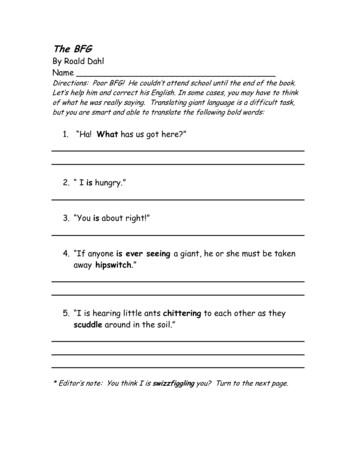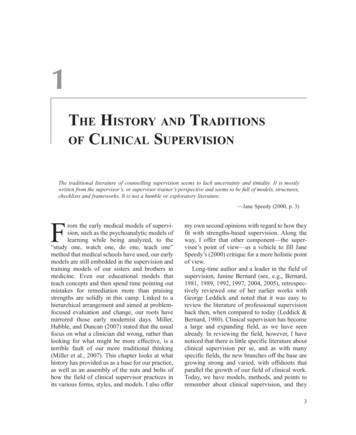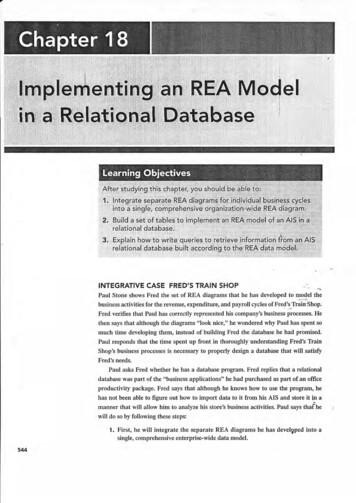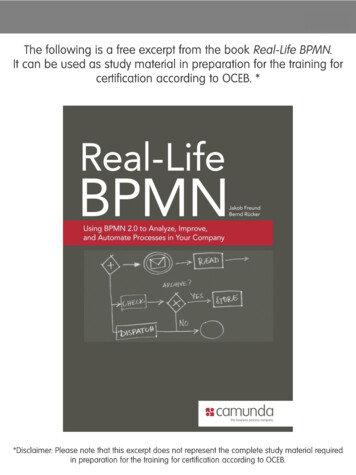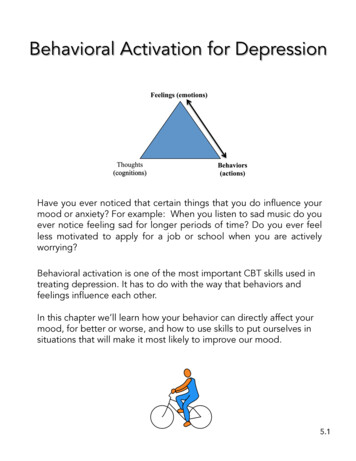
Transcription
Have you ever noticed that certain things that you do influence yourmood or anxiety? For example: When you listen to sad music do youever notice feeling sad for longer periods of time? Do you ever feelless motivated to apply for a job or school when you are activelyworrying?Behavioral activation is one of the most important CBT skills used intreating depression. It has to do with the way that behaviors andfeelings influence each other.In this chapter we’ll learn how your behavior can directly affect yourmood, for better or worse, and how to use skills to put ourselves insituations that will make it most likely to improve our mood.5.1
Behavioral Activation (BA) is a specific CBT skill. It canbe a treatment all by itself, or can be used alongsideother CBT skills such as cognitive restructuring.Behavioral activation helps us understand howbehaviors influence emotions, just like cognitive workhelps us understand the connection between thoughtsand emotions.Here are some examples of how BA may be used:Jim deals with depression and anxiety. He has a hard time figuring out why hismood drastically dips and also finds it difficult to understand why he feels betterfor short periods of time. While working with his schedule in therapy, he beganto discover specific mood triggers (how he spent his time or random events) thathe had never noticed before. He was able to become more aware of thesetriggers and change his approach, ultimately allowing him to change his mood.Debbie knew that her family history, stress with taking care of her special needsson, and seasonal change contribute to her depression. Though she knows thetriggers, she struggles with managing her mood as she often does not feel likedoing activities that will help her depression. She often tells herself that she willwait until it warms up outside to exercise and does not feel up to calling herfriends who usually cheer her up. With her therapist she began to find strategiesto help her motivation by practicing awareness of different avoidance patternsand developing alternative, adaptive behaviors.Will Behavioral Activation be helpful for me?Behavioral activation is helpful for many people. If you answer “yes” to any of the following questions,BA could be a good fit for you. Do I have a sense of what is triggering my mood or anxiety? Do I generally find myself doing very little, with little pleasure or meaning in my life? Are there times that I feel better or worse and I’m not sure why? Do I have a difficult time working with my negative thoughts, but seem to feel better when I can getmyself moving and doing something? Do I have a hard time even knowing what I enjoy or find meaning in?5.2
Behavioral Activation is based on the well-researched understanding thatdepression often keeps us from doing the things that bring enjoyment andmeaning to our lives. This “downward spiral” (explained in the first chapter ofthis manual) causes us to feel even worse. In Behavioral Activation we work toreverse this cycle using our actions and choices.Behavioral Activation involves: Understanding the “vicious cycles” ofdepression Monitoring our daily activities Identification of goals and values Building an upward spiral of motivation andenergy through pleasure and mastery Activity Scheduling: purposefully schedulingin enjoyable and meaningful activities Problem solving around potential barriers toactivation Reducing avoidance Working as a team to make gradual,systematic, sustained progress. Changedoesn’t happen over night! Using between-session assignments. Practicechanges the brain, little by little!“But my depression is ‘situational!’”Yes, it is true that often depression is set in motion by difficult events that happen to us. If you aredealing with a big loss, stressful situation, or change in your life, feelings of depression could be aresult. While it is important to address these external events and sometimes to talk about the past, itis also important to find ways to address our current situation, find ways to fulfill on our future lifeaims, and find time for enjoyment. Behavioral Activation can help with this part of treatment.5.3
Action precedes emotion!?We often wait to feel better or more motivated beforedoing something.Remember that anxiety and depression come fromparts of our brain that are really trying to protect us bygetting us to avoid or isolate. This means that as longas we are following the lead of the anxiety anddepression, we will continue to feel less motivated andwant to avoid and isolate.So why activate first? Firstly, activating changes our brain state and can make usfeel better, right away. For example, exercise can produce “good chemicals” inthe brain that lift mood while they are in the bloodstream. Secondly, the morethat we activate, the more situations we find ourselves in that can give us positiveexperiences. The technical term for this is “reinforcing positive contextcontingencies.” Technicalities aside, we need to “get out there” and giveourselves the best chance of feeling better, even if we don’t feel like it at thetime.So, when we are feeling anxious and depressed,we cannot wait on the brain to give us themotivation to get out there and do things.Research has shown that our decision to activate (inother words, to do the opposite of what thedepression wants us to do, and do something inline with our values and goals) is necessary foremotions to change.Note: Behavioral Activation hasbeen shown in research studies tobe effective on its own for somepeople to overcome depression.However, it is often used alongsideother therapeutic skills, as it maynot address your specific situationall by itself. Consider it just one ofmany options in your effort tomanage depression.On the next few pages weillustrate the “vicious cycles” ofdepression, according to theresearch on depression andBehavioral Activation.5.4
Events often getthe depression“ball rolling.”This could besomething newor a reminderfrom a paststressful event.What happened(stressful life events, triggers from past, etc.)“I lost my job”“We had our first child”How you feel(emotions)SadAnxiousStressedShut downEmbarrassedThe stress ofevents leads tonegativeemotions thatare distressingand make uswant to drawback.FIRSTVICIOUSCYCLEWhat you do(or don’t do)Emotions leadto behaviors: weavoid or isolate,which makes usfeel worse.Stay in bedDon’t engage with familyDon’t return calls or textsAvoid people5.5
Avoidance,isolation, andother behaviorscause furthernegative events,making us feeleven moredepressed.What happened(life events, triggers, etc.)“I lost my job”“We had our first child”* Increased odds of more hardships and negative life eventsMy friends stop calling me because I never return calls or textsSECONDVICIOUSCYCLEHow you feel(emotions)SadAnxiousStressedShut downEmbarrassedFIRSTVICIOUSCYCLEWhat you do(or don’t do)Stay in bedDon’t engage with familyDon’t return calls or textsAvoid people5.6
Try to determine your own “vicious cycles,” identifying specific events, emotions, and responses.What happened(life events, triggers, etc.)How you feel(symptoms)What you do(or don’t do)5.7
Being aware of our mood,emotions, and behaviors is animportant part of CBT. In order toknow what to do to fix a problem,we first need to understand what isgoing on!Activity Monitoring is the first stepof Behavioral Activation. It isimportant to know exactly what weare doing throughout the day, andhow this corresponds to our mood.While we can’t fix the depressionjust by noticing this, we can take astep toward feeling better byunderstanding which behaviorshelp us feel better, which continueto maintain the depression as it is,and which make us feel worse.Use the Activity Monitoring Charton the next page to start trackingyour activities and mood.Get out that pen and paper!Research shows that people whowrite things down as part of CBTpractice do better than those that tryto do it all in their heads. While itdoes involve more work (and mayseem like going back to school), wehope you will give it a try at first, untilthe skills become more natural.5.8With BA, we rate mood on a scale of 0-10, 10being the best, 0 being the worst. We askpeople to rate mood in each hour to the bestof their ability in order to understand moodchanges.For example:Monday:!8am: Woke up (5)!9am: Went to go eat breakfast (6)!10am: Got to work, talked to Bob (5)!11am:Sitting at my desk reading e-mails (3)!12pm:Eating lunch at my desk, worryingabout meeting (3)!1pm:Meeting, thinking about issue withreports that I missed, tired (3)!2pm: Sitting at my desk working (4)!3pm: Working (4)!4pm: Working (4)!5pm: Driving home (6)!
Instructions: Record your activity for each hour of the day (what you were doing, with whom,where, etc.). Record a rating for your mood as you were doing each activity. Mood is ratedbetween 0-10, with “0” indicating “low mood” and “10” indicating “good mood.”SunMonTuesWedThursFrSat5-7:00am7:00 am8:00 am9:00 am10:00 am11:00 am12:00 pm1:00 pm2:00 pm3:00 pm4:00 pm5:00 pm6:00 pm7:00 pm8:00 pm9:00 pm10:00 pm11:00 pm5.9
Based on the mood ratings you recorded on the Activity Monitoring Worksheet, determine whichactivities helped you to feel more positive (“UP” activities) and which led to feeling down(“DOWN” activities).Antidepressant/UP ActivitiesDepressant/DOWN ActivitiesIn Behavioral Activation, one of our aims is to increase “UP” activities and decrease “DOWN”activities. Over the next section we will learn more about the types of activities that will lead tobetter mood, to add to the list above. Over time, we can replace the “DOWN” activities withmore “UP” ones.5.10
A Life Worth Living: Values, Pleasure, Mastery, and GoalsThe next step in Behavioral Activation is determining the behaviors on which tofocus to improve our mood. While some behaviors, like exercise and meditation,can be used right away to improve mood directly, many of the behaviors that arelikely to help us are those that align with the things that we enjoy or areimportant to us.An exploration of “values,” “pleasure,” and “mastery” describe much of the“stuff” that makes life worth living. This process can help us come up withtangible goals to move us toward the things that are most important to us.“Values” are what we find meaningful in life. Theyare the most important things to us. Everyone hasdifferent values, and for each of us they canchange over time. They are like a compass,pointing us in the direction we want to go.“Pleasure” involves activities, or “play” that we enjoy for the sakeof the activity itself. Hobbies, games, spending time in nature, orspending time with a good friend.“Mastery” involves activities, such as work or sports, thatinvolve the development of skills; we are able toaccomplish things and feel a sense of mastery over ourenvironment. When enjoyed in moderation anddiversified well with other activities, they can increasepositive emotions and improve how we feel aboutourselves. Also, we may feel more creative as we learn tomaster certain skills, adding to the possibilities ofenjoyment.Goals and objectives outline the steps we take to experience our lives morefully. They give us targets to help us experience more pleasure, mastery, andvalue-driven behavior.To feel more consistently engaged and happy in the world, it is usually best tofind a balance of goals centered on values, pleasure, and mastery. How thatbalance looks for you will be unique. On the following pages, we will help youunderstand how this balance might look for your own life.5.11
As we mentioned earlier, “values” are what we findmeaningful and important. These can be different fordifferent people.Values are important to explore, because much of ourgoal-directed activity comes from a foundation of whatis valued. For example, one may value a healthylifestyle, and a related goal may be to exercise daily.We may value family, and therefore choose toschedule in time with them. Or if we don’t have afamily, our activities could lead to getting married andstarting one.It is common to mistake certain wishes and feelings forvalues. Values are not internal states, how people treatus, or specific things to achieve.On the next page is a list of valuesthat are related to the categoriesbelow. Use them to start listing yourown values on the following page.Below are some of the common areas of life thatpeople value and may lead to goal-directed activity.Physical well-beingWhat kind of values do youhave regarding your physicalwellbeing? How do you wantto look at yourself?Family relationshipsWhat kind of relationships do youwant with your family? What kind ofmother/father/ brother/sister/uncle/aunt do you want to be? What isimportant to you about a goodfamily?Intimate relationshipsWhat kind of partner do youwant to be? What quality ofrelationship do you want to bepart of? How do you want tospend time together?Citizenship/CommunityMental/Emotional HealthWhat kind of environmentdo you want to be a part of?How do you want to contribute to your community?What helps you maintainsound mental health? Why isthis important to you? Whatissues would you like toaddress?SpiritualityFriendships/social relationsWhat kind of relationship doyou want with God/nature/ theEarth/mankind? What doeshaving a spiritual life mean toyou? How can you exercise this?Hobbies/ RecreationHow would you like to enjoyyourself? What relaxes you?When are you most playful? Arethere any special interests youwould like to pursue?What sort of friend do you wantto be? How would you like toact towards your friends? Howcan these relationships beimproved?Education/training/personal growthHow would you like to grow?What kind of skills would youlike to develop? What wouldyou like to know more about?Employment/careerWhat kind of work is valuable toyou? What qualities do youwant to bring as an employee?What kind of work relationshipswould you like to build?5.12
Values, con.Below is a list of general value categories, and some specific values that are common in each. Seeif any of them fit you, and use this page to fill out the values rating sheet on the next page.Family relations Work on current relationships Spend time with family Take an active role in raising my children Maintain consistent healthycommunicationMarriage/couples/intimate relationships Establish a sense of safety and trust Give and receive affection Spend quality time with my partner Show my partner how much Iappreciate themFriendships/Social Relationships End destructive relationships Reach out for new relationships Feel a sense of belonging Have and keep close friends Spend time with friends Have people to do things withMental/Emotional health Seek fun and things that give mepleasure Have free time Be independent and take care of myself Challenge my negative thinking Make my own decisions Engage in therapy Take my medications Stay activePhysical well-being Live in secure and safe surroundings Engage in regular exercise Have a steady income to meet physicalneeds Eat foods that are nourishing to mybody Maintain a balance between rest andactivity Get enough sleep5.13Citizenship/Community Contribute to the larger community Help people in need Improve society Be committed to a cause or group thathas a larger purpose Make sacrifices for othersSpirituality Follow traditions and customs Live according to spiritual principles Practice my religion or faith Grow in understanding myself, mypersonal calling, and life’s purpose Discern the will of God Find meaning in life Develop a personal philosophy of life Spend time in nature Focus on the greater goodEducation/Training/Personal Growth Be involved in undertakings I believepersonally are significant Try new and different things in life Learn new things Be daring and seek adventure Have an exciting life Learn to do challenging things that helpme grow as a personEmployment Be powerful and able to influenceothers, have authority Make important decisions that affect theorganization Be a leader Make a great deal of money Be respected by others Be seen by others as successful, beambitious Become well-known, obtain recognitionand status Be productive, work hard Achieve significant goals Enjoy the work I do Do what I’m told and follow the rules
Values, con.Here are some other experiments to explore your own values:1. Imagine that an important newscaster were doing a biographical story on your life.Think about how you’d want them to describe you. How would they describe the wayyou spent your time? How you related to others? What was most important to you?What are your strengths as a person? Write down a narrative of what they would say.2. Imagine you could read the mind of a person that’s important to you and with whomyou’ve had a good relationship. They are thinking all kinds of thoughts about yourqualities: what you stand for, what your strengths are, what you mean to him or her, andthe role you play in his or her life.3. Think about your heroes. They can be people directly in your life, or other people thatyou look up to, even fictional characters. What are their qualities? What do you admireabout them?4. Imagine you are writing your own autobiography. Imagine how you would like to liveyour life, barring all barriers, in the “best case scenario.” What are the things that aremost important to you in this scenario? What would you stand for? How would youspend your time?5. Imagine that someone is performing the eulogy at your funeral. Looking back on yourlife, they would be commenting on your strengths, values, and achievements. Howwould you want them to describe your life?6. If you are struggling to find a valued direction, commit to experimenting with some ofthe values on the previous pages for just one week. After choosing a value, plan tonotice your reactions to making the effort to hold to this value. Make a list of behaviorsthat might fit with the value and choose one behavior to try. Notice your judgmentsthat come up about choosing this behavior. Then make a plan to fulfill on the valuedriven behavior. Just do the behavior without telling anyone about it and see whathappens. Commit to following through on this behavior once per day for one week.Keep a diary of your reactions to behaving this way and others’ reactions to you. At theend of the week, reflect on your experiment with someone else, like a therapist orgroup leader.5.14
Values Rating SheetBased on your exploration of the previous pages, write a summary of your values. For example,“to live a healthy life and take care of my body” (physical well-being), or “to be a good friendto people who need me, and to enjoy time with people I love”(friendships).Rate each domain for how important it is to you from 0-10 (0 not important, 10 extremelyimportant).Remember: values are not internal states, how people treat us, or specific things to achieve.Physical well-beingFamily relationshipsIntimate RelationshipsMental/Emotional es/RecreationEducation/training/personal growthFriendships/social relationsEmployment/career5.15
The next step is to translate our values into activities that help us fulfill on those goals.Take a moment to think about the values that you identified on the previous page. What aresome short term goals in each area? What are some long term goals? Use this page and thenext to start to brainstorm. Write down your results on the upcoming page: “Values, Pleasure,and Mastery Master List.”VALUEACTIVITIESParentingExample:I want to be involved in mychildren’s interests andlearning. I’d like to build specialmemories with my kids andspend quality time with them.I’m going to attend thenext PTO meeting andmaybe contact theteacher to be aclassroom volunteer. Ican plan a small vacationto take with the kidsnext summer.5.16
VALUEACTIVITIES5.17
PleasurePleasure involves activities that we enjoy for the sake of the activity itself. There are many differentkinds of pleasure. Those that are most sustainable involve “play” such as hobbies and otherrecreational activities. Social activities can also involve pleasure. Other types of pleasure, such assensory experiences (food, drink, images, touch, etc.) can also be enjoyable if done in moderation.Below are examples of enjoyable activities that are enjoyed by many. Circle the ones that apply to you,and add others that aren’t included below.Social activities Hobbies, Interests, and other “play” ReadingTV, movies, playsDancingPlaying or listening tomusicBoard games or cardsArts and crafts, sewing, paintingCookingWalking, hiking, enjoying nature,fishingSports (basketball, softball,swimming, etc.) or going as aspectatorMartial arts (karate, etc.)Museums/zoosVideo gamesTraveling, sightseeing, goingto the beach, omedy: TV, recordings, liveReligion or spirituality Spending time with familyEnjoying own children and/or youngrelativesEnjoying close friendsHanging out with largegroups of friends/acquaintancesParties, meeting new peopleRomancePetsClubs: meeting people with similarinterestsEnjoying food and drink with othersSensory experiences Pleasant smells, images, sounds,physical touch, tastesTaking a bathListening to soothing musicMindful tastingOther?5.18
MasteryMastery involves activities, such as work or sports, that involve the development ofskills; we are able to accomplish things and feel a sense of mastery over ourenvironment. When enjoyed in moderation and diversified well with other activities,they can increase positive emotions and improve how we feel about ourselves.Here are some examples of how people experience mastery to experience fulfillmentin their lives. Circle the ones that apply to you, and add others that aren’t includedbelow.Job or Meaningful Daytime ActivityLook for or attempt to develop some of thesequalities in your occupation volunteer work, orother meaningful daytime activity: EnjoymentCreativityFeelings of competence (able toaccomplish tasks satisfactorily)Potential for development of skillsAbility to “move up” in the organization ortake on more responsibility, if this isdesiredSocial contact with coworkers, colleagues,others in the fieldOther skill-based activities SportsMusic practice and performanceHome improvement/buildingWoodworkingVisual art (painting, drawing,pottery, sewing, knitting Learning about interests(history, politics, food,language, culture, etc.) Crafting, pottery, and othercreative skillsOther?5.19
Here are some examples of activities that tend to increase pleasure and mastery. You might think of morethat are not listed. Circle the ones that you think could lead to enjoyment or mastery for yourself.1. Soaking in the bathtub2. Planning my career3. Collecting things (coins, shells, etc.)4. Going for a vacation5. Recycling old items6. Relaxing7. Going on a date8. Going to a movie9. Jogging, walking10. Listening to music11. Thinking I have done a full day’s work12. Recalling past parties13. Buying household gadgets14. Lying in the sun15. Planning a career change16. Laughing17. Thinking about my past trips18. Listening to others19. Reading magazines or newspapers20. Hobbies (stamp collecting, model building,etc.)21. Spending an evening with good friends22. Planning a day’s activities23. Meeting new people24. Remembering beautiful scenery25. Saving money26. Gambling27. Going to the gym, doing aerobics28. Eating29. Thinking how it will be when I finish school30. Getting out of debt/paying debts31. Practicing karate, judo, yoga32. Thinking about retirement33. Repairing things around the house34. Working on my car (bicycle)35. Remembering the words and deeds ofloving people36. Wearing sexy clothes37. Having quiet evenings38. Taking care of my plants39. Buying, selling stocks and shares40. Going swimming41. Doodling42. Exercising43. Collecting old things44. Going to a party45. Thinking about buying things46. Playing golf47. Playing soccer48. Flying kites49. Having discussions with friends50. Having family get-togethers51. Riding a motorbike52. Sex53. Playing squash54. Going camping55. Singing around the house56. Arranging flowers57. Going to church, praying (practicingreligion)58. Losing weight59. Going to the beach60. Thinking I’m an OK person61. A day with nothing to do62. Having class reunions63. Going ice skating, roller skating/blading64. Going sailing65.Travelling abroad, interstate or within thestate66. Sketching, painting67. Blowing bubbles68. Doing embroidery, cross stitching69. Sleeping70.Driving71.Entertaining72. Going to clubs (garden, sewing, etc.)73. Thinking about getting married74. Going bird watching75. Singing with groups76. Flirting77. Playing musical instruments78. Doing arts and crafts79. Making a gift for someone80. Buying CDs, tapes, records81. Watching boxing, wrestling82. Planning parties83. Cooking, baking84. Going hiking, bush walking85. Writing books (poems, articles)86. Sewing87. Buying clothes88. Working89. Going out to dinner90. Discussing books91. Sightseeing92. Gardening93. Going to the beauty salon94. Early morning coffee and newspaper95. Playing tennis96. Kissing97. Watching my children (play)98. Thinking I have a lot going for me99. Going to plays and concerts100. Daydreaming101. Planning to go to college or university5.20
102. Going for a drive103. Listening to a stereo104. Refinishing furniture105. Watching videos or DVDs106. Making lists of tasks107. Going bike riding108. Walks on the riverfront/shoreline109. Buying gifts110. Travelling to national parks111. Completing a task112. Thinking about my achievements113. Going to a sporting event114. Eating gooey, fattening foods115. Exchanging emails, chatting on theinternet116. Photography117. Going fishing118. Thinking about pleasant events119. Staying on a diet120. Star gazing121. Flying a plane122. Reading fiction123. Acting124. Being alone125. Writing diary/journal entries or letters126. Cleaning127. Reading non-fiction128. Taking children places129. Dancing130. Going on a picnic131. Thinking “I did that pretty well” afterdoing something132. Meditating/ Mindfulness exercises133. Playing volleyball134. Having lunch with a friend135. Making a gratitude list136. Thinking about having a family137. Thoughts about happy moments in mychildhood138. Splurging139. Playing cards140. Having a political discussion141. Solving riddles mentally142. Playing tennis143. Seeing and/or showing photos or slides144. Knitting/crocheting/quilting145. Doing crossword puzzles146. Shooting pool/Playing billiards147. Dressing up and looking nice148. Reflecting on how I’ve improved149. Buying things for myself150. Talking on the phone151. Going to museums, art galleries152. Thinking religious thoughts153. Surfing the internet154. Lighting candles155. Listening to the radio156. Spending time in nature157. Having coffee at a cafe158. Getting/giving a massage159. Saying “I love you”160. Thinking about my good qualities161. Buying books162. Having a spa, or sauna163. Going skiing164. Going canoeing or white-water rafting165. Going bowling166. Doing woodworking167. Fantasizing about the future168. Doing ballet, jazz/tap dancing169. Debating170. Playing computer games171. Having an aquarium172. Erotica (sex books, movies)173. Going horseback riding174. Going rock climbing175. Thinking about becoming active in thecommunity176. Doing something new177. Making jigsaw puzzles178. Thinking I’m a person who can cope179. Playing with my pets180. Having a barbecue181. Rearranging the furniture in my house182. Buying new furniture183. Going window shopping184. Saying yes to an opportunity5.21
Values, Pleasure, and Mastery Activities ListLook back at the last 6 pages and write down the activities you came up with to form amaster list of possible activities that fit with your life aims. We’ll use these to start toget more active with Behavioral 7.7.8.8.9.9.10.10.Valued Activities1.2.3.4.5.6.7.8.5.22
Goal SettingGoals are how we make our values, pleasure, and masteryactivities real and practical. On the next few pages we willstart to schedule the activities that we recorded on theValues, Pleasure, and Mastery Activities List. Before we do,it is important to be sure we are being “SMART” aboutsetting these goals. Use the following tips to increase thechances of reaching your goals.In order for goals to be achieved, they must be “SMART:”Specific: when creating a goal, state exactly what you want to achieve.Think about how and when you are going to achieve your goal. Forexample, “I want to lose ten pounds in two months by counting calories.”Measurable: in order to say you met a goal, one must be able tomeasure it. Stating that “I want to eat more fruits and vegetables” is notas measurable as stating “I want to eat a combination of 5 fruits andvegetables a day.”Attainable: Is the goal possible? If the goal is to get into shape byswimming 30 laps a day and you have never swum for exercise, you willbe setting yourself up for avoidance and discouragement. Choose asmaller goal, like taking a few swimming lessons or just swimming a fewlaps to start.Realistic: is the goal realistic? If you have had a knee injury or chronicpain, it is probably not realistic to set a goal for yourself of joining akickboxing class. Perhaps joining a walking program would be morerealistic.Trackable: tracking your progress helps us notice improvement. Whenwe recognize our improvement, it motivates us to continue our goodwork. It can also help in creating future goals.5.23
So far, we have determined how you spend yourtime and how your current activities areassociated with your mood. started to understand your values,enjoyable activities, and activities thatmake you feel a sense of mastery andaccomplishment. We’ve connectedthese with specific activities that youwrote on the Values, Pleasure, andMastery Activities List. learned how to be smart abou
“stuff” that makes life worth living. This process can help us come up with tangible goals to move us toward the things that are most important to us. Goals and objectives outline the steps we take to experience our lives more fully. They give us targets to help us expe

